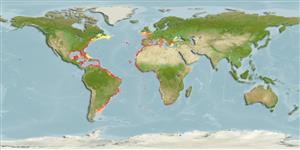Common names from other countries
Environment: milieu / climate zone / depth range / distribution range
Ecologia
marinhas; estuarina associadas(os) a recifes; intervalo de profundidade 1 - 100 m (Ref. 26999). Subtropical; 52°N - 45°S, 98°W - 36°E
Eastern Atlantic: English Channel to Angola, including the Mediterranean, Madeira, and the Azores. Western Atlantic: Canada (Ref. 5951) to Massachusetts, USA and the Gulf of Mexico to Argentina.
Length at first maturity / Tamanho / Peso / Idade
Maturity: Lm 19.5 range ? - ? cm
Max length : 50.0 cm SL macho/indeterminado; (Ref. 6544); common length : 38.0 cm TL macho/indeterminado; (Ref. 3397); peso máx. Publicado: 1.8 kg (Ref. 4699)
Descrição breve
Chaves de identificação | Morfologia | Morfometria
Espinhos dorsais (total) : 7; Raios dorsais moles (total) : 8; Espinhos anais: 0; Raios anais moles: 6. Pectoral fin very large and fan-like, with front 6 rays separated as small lobe (Ref. 26938).
Found on sand, mud or over rocks in sandy areas, exploring the bottom with the free part of the pectoral fins (Ref. 6544). Feeds primarily on benthic crustaceans, especially crabs, clams and small fishes. Neither anterolateral glandural groove nor venom gland is present (Ref. 57406).
Life cycle and mating behavior
Maturities | Reprodução | Spawnings | Egg(s) | Fecundities | Larvas
Eschmeyer, W.N. and L.J. Dempster, 1990. Dactylopteridae. p. 690-691. In J. C. Quero, J. C. Hureau, C. Karrer, A. Post, and L. Saldanha (eds.) Check-list of the fishes of the eastern tropical Atlantic (CLOFETA). JNICT, Lisbon; SEI, Paris; and UNESCO, Paris. Vol. 2. (Ref. 10782)
Categoria na Lista Vermelha da IUCN (Ref. 130435)
CITES (Ref. 128078)
Not Evaluated
Ameaça para o homem
Harmless
Utilização humana
Pescarias: pouco comercial; peixe desportivo: sim; Aquário: Espécies comerciais
Ferramentas
Relatórios especiais
Descarregue XML
Fontes da internet
Estimates based on models
Preferred temperature (Ref.
115969): 13.3 - 27.8, mean 23.9 (based on 1072 cells).
Phylogenetic diversity index (Ref.
82804): PD
50 = 1.0078 [Uniqueness, from 0.5 = low to 2.0 = high].
Bayesian length-weight: a=0.00977 (0.00739 - 0.01292), b=2.98 (2.90 - 3.06), in cm Total Length, based on LWR estimates for this species (Ref.
93245).
Nível Trófico (Ref.
69278): 3.7 ±0.5 se; based on diet studies.
Resiliência (Ref.
120179): Médio, tempo mínimo de duplicação da população 1,4 - 4,4 anos (Preliminary K or Fecundity.).
Fishing Vulnerability (Ref.
59153): Moderate vulnerability (37 of 100).
